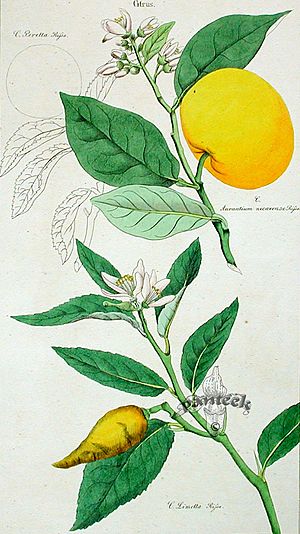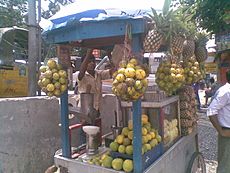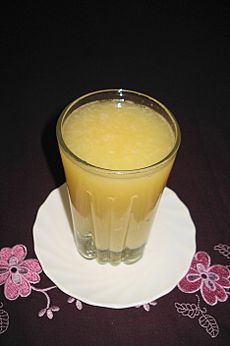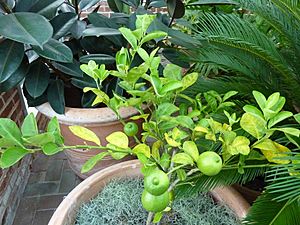Citrus limetta facts for kids
Quick facts for kids Citrus limetta |
|
|---|---|
 |
|
| Scientific classification | |
| Genus: |
Citrus
|
| Species: |
limetta
|
Citrus limetta, also known as sweet lime, mousami, or mosambi, is a type of citrus fruit. It looks like a small, round lime but tastes sweet. This fruit is a mix between a citron and a bitter orange.
Sweet lime originally comes from southern Iran. It is also grown in countries around the Mediterranean Sea.
- In Iran, it is called limu shirin, which means 'sweet lemon' in Persian.
- In India, it has many names like mausambi, mosambi, or musambi.
- In Bangladesh, people call it musambi or mosambi.
- In Nepal, it is known as mausam.
- In Pakistan, it is usually called musami.
- In the Dominican Republic, it is called limón dulce or sweet lime because of its sweet taste.
- In France, it is sometimes called bergamot, but it is not the same as the Bergamot orange.
Sweet lime is different from sour limes like the Key lime and Persian lime. Scientists have found that it is very similar to another fruit called Rhobs el Arsa. Both likely came from similar parent citrus trees.
The sweet lime varieties grown in South Asia came from Mozambique. Portuguese traders brought them to South Asia. The common name "musambi" comes from Mozambique.
Contents
What is Sweet Lime?

The sweet lime tree is small, growing up to 8 meters (about 26 feet) tall. It has branches that grow in different directions and smooth, brownish-grey bark. The tree has many thorns, which can be 15 to 75 millimeters (about 0.5 to 3 inches) long.
Its leaves are long, about 50 to 170 millimeters (2 to 6.7 inches) long and 28 to 89 millimeters (1.1 to 3.5 inches) wide. The flowers are white and about 20 to 30 millimeters (0.8 to 1.2 inches) wide.
The fruits are oval and start green, then turn yellow when they ripen. The inside of the fruit is greenish. The white part under the skin is about 5 millimeters (0.2 inches) thick. Even though it's called "sweet lime," the fruit looks more like a greenish orange.

Sweet lime trees grow well in warm, tropical, and subtropical places. They start producing fruit when they are 5 to 7 years old. They produce the most fruit between 10 and 20 years old. New trees are grown from seeds.
Taste and Flavour

As its name suggests, sweet lime has a sweet and mild taste. It still has a hint of lime flavour. The taste of the juice can change quickly when it touches the air, becoming a bit bitter. So, it's best to drink it soon after it's squeezed.
Sweet lime is not as sour as other citrus fruits because it has less acid. Its flavour can be compared to limeade or a pomelo.
How People Use Sweet Lime
Sweet lime is often served as juice. It is also a good mixer for drinks. It is the most common citrus juice available in the Indian subcontinent. You can often find its juice sold at roadside stalls.
Like most citrus fruits, sweet lime is full of vitamin C and antioxidants. A 100-gram serving provides about 50 milligrams of vitamin C. In Iran, people often use it as a home remedy to help with the common cold and influenza (flu).
The sweet lime tree is also used as an ornamental plant in gardens. Sometimes, it is used as a base for grafting other citrus trees.
| Nutritional value per 100 g (3.5 oz) | |
|---|---|
| Energy | 180 kJ (43 kcal) |
|
9.3 g
|
|
| Sugars | 1.7g |
| Dietary fibre | 0.5 g |
|
0.3 g
|
|
|
Protein
|
0.7-0.8 g
|
| Vitamins | Quantity
%DV†
|
| Vitamin C |
60%
50 mg |
| Minerals | Quantity
%DV†
|
| Calcium |
4%
40 mg |
| Iron |
5%
0.7 mg |
| Phosphorus |
4%
30 mg |
| Potassium |
16%
490 mg |
| Other constituents | Quantity |
| Water | 88 g |
| †Percentages estimated using US recommendations for adults. | |
Picking Ripe Sweet Limes
Sweet limes do not ripen after they are picked from the tree. They must be fully ripe when harvested. A ripe sweet lime is about the size of a tennis ball and has a shiny greenish-yellow colour.
To check if it's ripe, gently scratch the surface with your fingernail. If you can smell its oils, it is likely ripe. The juiciest fruits will feel heavy for their size.
Fruit that is not ripe will feel light and hard, and its inside will be tart. Overripe fruit looks dull and shrunken, with dry, spongy skin. Try to avoid fruits that have brownish-yellow spots.
Storing Sweet Limes
Sweet limes can stay fresh for up to two weeks at room temperature. If you keep them in the refrigerator, they can last for four to eight weeks.
You can freeze sweet lime juice for up to six months. It is also possible to freeze slices of the fruit. However, a substance called limonin might make the fruit taste bitter over time. To avoid this, you can put the slices in sweet syrup inside an airtight glass jar.
See also
 In Spanish: Citrus × limetta para niños
In Spanish: Citrus × limetta para niños



